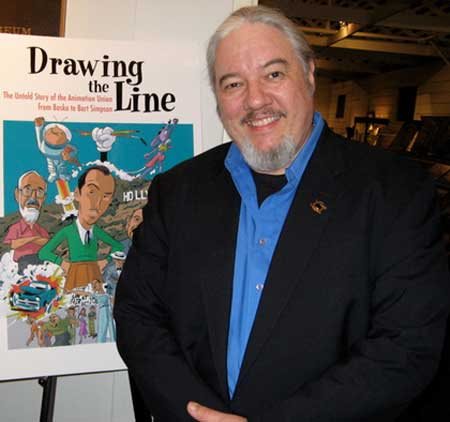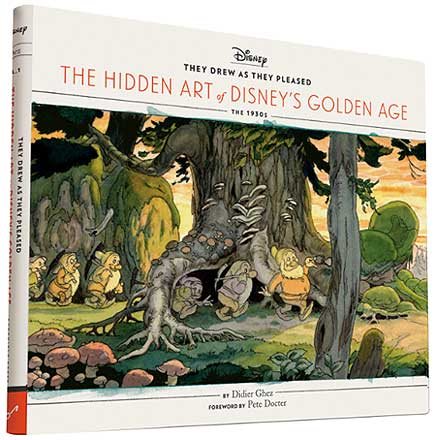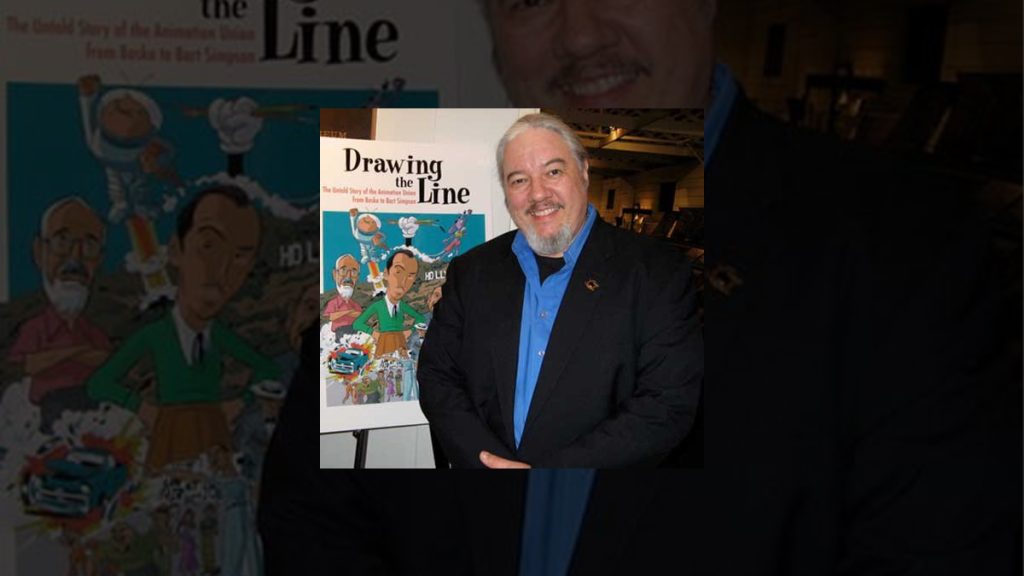Do you want to learn about what REALLY happened back in the
day at Disney Studios? Sorry, but you probably won't get the complete picture
from watching a certain four-hour television special. And Tom Sito is busy with
his day job at USC's animation department. He tells the most balanced history
of The Strike I've ever heard.

Tom Sito & his excellent animation history book, "Drawing the Line: The
Untold Story of the Animation Union from Bosko to Bart Simpson."
No, in order to get an in-depth understanding of the way
things really were at the Mouse House, you'll have to pick up a book and read
it. They're heavy. They're pricey. They smell good.

Didier Ghez
And if you're looking for in-depth Disney history, you honestly
can't do better than Didier Ghez. I'm biased, because I've been a fan of
Didier's writing since he was a teenager making Disney fanzines in France.
When Walt Disney Animation Studios opened in France,
he got to the Brizzi Brothers and the rest is, well, history. Didier never gave
up and he never stopped working, and now he's the author of a bunch of Disney
books. His "Walt's People" series — for example — is all interviews
with people who actually knew and worked with Walt. No second-guessing,
play-acting nor psychology. Just memories and experiences from those who were
actually there.

Copyright 2015 Chronicle Books. All rights reserved
His newest book is a marvel, and the culmination of a
life-long dream for him. Well, actually, it's part one of six parts of a
lifelong dream. This is the first of six volumes of "They Drew as They
Pleased — The Hidden Art of Disney's Golden Age: The 1930s," (Chronicle
Books, September 2015) which will be followed by two volumes about the 1940s,
one for the 1950s, one for the 1960s & 1970s and one for the 1980s &
1990s. If you have a plethora of Disney animation history books on your shelf,
you probably have several images that are burnt into your mind, because you see
them over and over. Not here. Thanks to Disney's ARL (i.e., Animation Research
Library), you're going to be seeing art that the public has never, EVER seen
before.
Bianca Majolie concept art for Disney's "Cinderella." Copyright Disney
Enterprises, Inc. All rights reserved
"They Drew as They Pleased — The Hidden Art of
Disney's Golden Age: The 1930s"examines the work of artists Albert Hurter,
Ferdinand Horvath, Bianca Majolie and Gustaf Tenggren. Majolie was the first
woman hired in the story department – yes, in the 1930s, Meryl. In fact, a
great deal of the series covers the contributions of female artists to the
legendary Disney film library. You won't be seeing a lot of Mickey Mouse and
Jiminy Cricket stills here. This is concept work: the seeds that planted the
story. In the 1930s, Walt Disney Animation Studios was just coming into being.
It was a thing that had never existed before; every part of it was new and
unexplored. Walt figured out that a Story
Department would probably be a good
thing. And so the story department is a part of animation to this day.
Gustaf Teggren's concept painting for "Hi-Diddle-Dee-Dee (An Actor's Life for
Me)" song in Disney's "Pinocchio." Copyright Disney Enterprises, Inc.
All rights reserved
You won't see their exact work in most of the films, but
you'll definitely see the influence, especially Majolie's influence in The
Nutcracker Suite in "Fantasia" and Tenggren's in "Pinocchio."
This isn't a concept new to Disney animation fans, but never before has it been
studied in this much depth and detail. "They Drew As They Pleased — The
Hidden Art of Disney's Golden Age: The 1930s" is a treasure, and a gift to
future generations of art students.
Ferdinand Horvath
There's also a bit of adventure behind this book: Ghez got
hold of animation historian John Canemaker's notes from New
York University.
As he was going through them, he learned that one of his book's subjects, Ferdinand
Horvath, had left behind a series of diaries, but that they had been sold to a
dealer in Los Angeles; Canemaker
had never been able to find them.
Concept art for the Prince's arrival at the Evil Queen's palace in Disney's "Snow
White & the Seven Dwarfs." Copyright Disney Enterprises, Inc.
All rights reserved
A friend helped him find the dealer, even though over 20 years had
passed, and Ghez attempted contact, leaving a message on his answering machine
and hoping for the best. A week later, Ghez checked his phone between meetings
on a business trip and saw an unfamiliar number. He decided to call back and
found himself speaking to the son of the original dealer, who was very much
alive and standing nearby – and he still had the diaries! Soon thereafter, Ghez
was the owner of not only a huge amount of diaries, but also a stack of
correspondence between Horvath and his wife…in Hungarian. And the diaries were
in German. Fortunately, Didier has friends all over the world, and a few of
them were kind enough to tackle translation duties. The vast amounts that
didn't make the book will still reach people via Ghez' "Walt's People"
series in the future. I love a happy ending. Even if you're not a hardcore
animation buff, "They Drew as They Pleased — The Hidden Art of Disney's
Golden Age: The 1930s" is a treasure.
